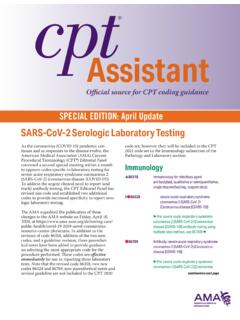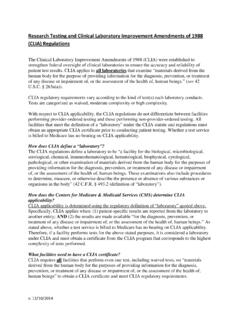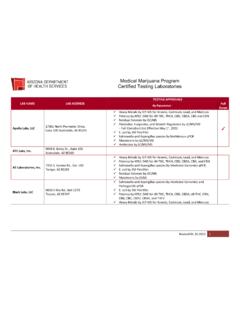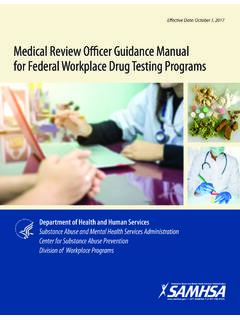Transcription of SELF-ASSESSMENT CHECKLIST FOR GOOD TESTING PRACTICES
1 SELF-ASSESSMENT CHECKLIST . FOR GOOD TESTING PRACTICES . The following SELF-ASSESSMENT CHECKLIST emphasizes recommended PRACTICES for physicians, nurses, medical assistants, pharmacists, and others who perform patient TESTING under a Clinical laboratory Improvement Amendments (CLIA) Certificate of Waiver. It can be used as a voluntary tool to help assure good TESTING PRACTICES and reliable, high quality test results. Sites that perform TESTING under a CLIA Certificate of Waiver must meet the following requirements: enroll in the CLIA program; pay applicable certificate fees biennially; and follow the current manufacturer's instructions provided with the test.
2 Resources that can be used to supplement this CHECKLIST include: DISCLAIMER. Although some of the recommendations in this SELF-ASSESSMENT CHECKLIST exceed CLIA requirements for waived TESTING , following these good TESTING PRACTICES will likely lead to reliable, high quality test results and will enhance patient safety. Center for Surveillance, Epidemiology and laboratory Services Division of laboratory Systems (DLS). YES NO N/A. REGULATORY REQUIREMENTS. Do you have a current CLIA Certificate of Waiver (CW)? Do you renew the Certificate of Waiver every 2 years? Do you perform only CLIA waived tests? Do you follow any additional TESTING requirements for your state?
3 Do you follow Occupational Safety and Health Administration (OSHA) safety regulations for occupational exposure to bloodborne pathogens? SELF-ASSESSMENT . READY YES NO N/A. Do you clean work surfaces before and after TESTING ? Do you perform TESTING in a well-lighted area? Do you check and record temperatures of the TESTING and reagent storage areas daily? Do you check inventory regularly to ensure you will have enough reagents and supplies on hand for TESTING ? Do you store all reagents and media as recommended by the manufacturer? Do you document expiration dates of reagents/kits, and discard any reagents or tests that have expired?
4 Do you ensure that reagents from different lot numbers are not mixed together? Do you inspect reagents for damage, discoloration, or contamination and discard if found? Do you prepare reagents according to manufacturer's instructions? Do you allow time for refrigerated reagents/samples to come to room temperature prior to TESTING if required by the manufacturer's instructions? Do you inspect equipment and electrical connections to be sure they are safe and working properly? Do you perform equipment calibration checks, as needed, following the manufacturer's instructions? Do you check the manufacturer's instructions with each new lot and shipment of test kits to make sure there are no changes from the test kits being used?
5 Do you file the old manufacturer's instructions and replace with the new copy if there are changes? Do you communicate all changes in the manufacturer's instructions to other TESTING personnel and to the person who directs or supervises TESTING ? Do you treat and test quality control (QC) samples the same as patient samples? Do you perform QC as recommended in the manufacturer's instructions? Do you make sure your QC results are as expected before performing patient TESTING ? Do you identify and correct problems if QC results are not as expected? SET YES NO N/A. Do you follow the manufacturer's instructions for use of the appropriate collection device and sample volume needed for TESTING ?
6 Do you follow instructions for samples that need special timing for collection? Do you only use unprocessed samples for performing waived test? Do you check patient identification with test orders? Do you positively identify the patient before collecting a sample? Do you discuss any preparation, pretest instructions, and counseling needs with the patient before collecting the sample? Do you wear appropriate personal protective equipment (PPE) such as gloves when collecting the sample and TESTING ? Do you properly label the sample collection device? Do you follow all test requisition, sample collection and handling specifications of the referral laboratory if applicable?
7 Do you clean your hands and change gloves between patients? Do you keep disinfectants nearby for sanitizing bench tops and treating spills? Does your TESTING site have established criteria for sample rejection? Do you use the proper biohazard containers to dispose of waste and sharps? TEST YES NO N/A. Do you document that all staff have satisfactorily completed initial training before performing temperature checks, blood collection, sample TESTING , and reporting patient results? Do you test samples that are properly collected or handled? Do you have the current manufacturer's instructions or a quick reference guide at the work station?
8 Do you follow the manufacturer's instructions in the exact order? Do you use timers and follow the required timing intervals before reading test results? Do you detect, identify, and correct laboratory errors before reporting test results? Do you identify and document critical results? Do you know who to contact if you need to report a critical test result? Do you make sure patient reports are legible and reported in a timely manner? Do you report patient test results only to authorized persons? Do you document verbal reports followed by a written test report? Do you make sure reports are standardized and easily distinguishable from referral laboratory test reports?
9 Do you have written site specific policies and procedures to ensure confirmatory or additional TESTING is performed or referred, when needed? Do you have a procedure to detect test result errors, so that you promptly notify the responsible clinical personnel or reference laboratory and issue a corrected report? Do you keep records of TESTING , including equipment logs, maintenance records, QC documents, and test results? Do you have a regular schedule for maintaining TESTING equipment? Do you have instructions for troubleshooting TESTING problems? Do you dispose of biohazardous waste and sharps containers safely?
10 Do you report confirmed positive infectious disease test results to public health agencies? Do you voluntarily participate in proficiency TESTING ? Do you monitor and evaluate your TESTING process to identify areas for improvement?















